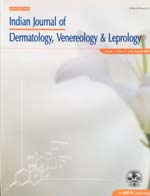
|
Indian Journal of Dermatology, Venereology and Leprology
Medknow Publications on behalf of The Indian Association of Dermatologists, Venereologists and Leprologists (IADVL)
ISSN: 0378-6323
EISSN: 0378-6323
Vol. 76, No. 6, 2010, pp. 662-665
|
 Bioline Code: dv10197
Bioline Code: dv10197
Full paper language: English
Document type: Research Article
Document available free of charge
|
|
|
Indian Journal of Dermatology, Venereology and Leprology, Vol. 76, No. 6, 2010, pp. 662-665
| en |
Prevalence of metabolic syndrome in patients with psoriasis
Nisa, Nuzhatun & Qazi, Masood A.
Abstract
Background: Psoriasis is a chronic inflammatory
disease of the skin and is associated with an increased risk of cardiovascular
atherosclerosis. Metabolic syndrome, a conglomerate of various clinical and
biochemical parameters is a significant predictor of atherosclerotic disease
and the associated risk for cardiovascular events in such patients.
Aim: To investigate the prevalence of metabolic syndrome in
patients with psoriasis.
Methods: The study was a prospective, hospital based case-control
study involving 150 adult patients with chronic plaque psoriasis and 150
healthy controls. Venous samples were taken at the enrolment visit after
the subjects had fasted overnight (at least 8 h). Serum cholesterol and
triglycerides were measured with enzymatic procedures. Plasma glucose
was measured using a glucose oxidase method. Metabolic syndrome was
diagnosed by the presence of three or more criteria of the National
Cholesterol Education Programme′s Adult Panel III (ATP III).
Statistical analysis of the data was done using statistical processing
software (SPSS-17) and epi-info software.
Results: Metabolic syndrome was significantly more common in
psoriatic patients than in controls 42(28%) vs 9(6%),
odds ratio (OR) = 6.09, P<0.05. Psoriatic patients also had a
significantly higher prevalence of hypertriglyceridaemia (73/150 among
cases vs 24/150 among controls; P<0.05), arterial
hypertension (74/150 among cases vs 24/150 among controls; P<0.05)
and impaired fasting plasma glucose levels (27/150 among cases vs 04/150
among controls; P<0.05). Psoriatic patients with metabolic syndrome
had mean disease duration of 13.67±11.87 years against 6.46±5.80
years in those without metabolic syndrome.
Conclusion: There is a significantly higher prevalence of metabolic syndrome in psoriasis patients as compared to general population and so is the risk of having atherosclerotic adversity. While managing the psoriatic plaques of these patients, concerns should extend to the atherosclerotic plaques as well.
Keywords
Inflammatory states, metabolic syndrome, psoriasis
|
| |
© Copyright 2010 Indian Journal of Dermatology, Venereology, and Leprology.
Alternative site location: http://www.ijdvl.com
|
|
